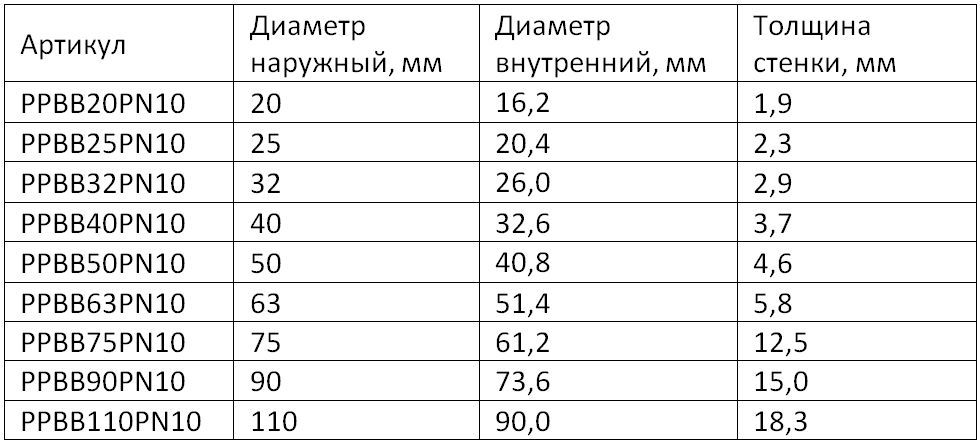Content
- General properties and scope
- Classification and Specifications
- Choice of pipe: what to look for
Progress does not stand still: these days, massive steel pipes are no longer in demand, and in their place came a reinforced polypropylene pipe or, more simply, plastic. These products are convenient to store, transport and install, which is an important advantage for every craftsman, from beginner to professional.

General properties and scope
Let's look at the technical specifications of polypropylene pipes. How do they stand out among similar products from other materials?
Main advantages:
- polypropylene products are cheaper than their steel counterparts;
- low weight polypropylene pipes;
- service life of polypropylene pipes - reaches 50 years;
- lack of need for special care (there is no need to paint or process them in any way (it is enough to wipe occasionally with a damp cloth from dust);
- with a huge selection of fittings it is possible to design a wiring system of any complexity;
- resistance to corrosion;
- minimum possibility of pressure loss;
- high throughput;
- material safety (environmentally friendly non-toxic type of plastic);
- during prolonged use, no deposits are formed on the inner surface of the product.

Application area:
- hot and cold water supply;
- water floor heating system;
- distribution of central heating;
- drinking water supply;
- sewage system;
- ventilation systems.

Polypropylene pipes have characteristics sufficient for transporting (in the pipeline system) compressed air and chemically active liquids. Thus, there are practically no restrictions on the operation of polypropylene pipes, it is enough to choose the right type, based on the designation and marking.
Classification and Specifications
Types of polypropylene pipes are divided into single-layer and multi-layer. The classification of polypropylene pipes is more complex and is divided into chemical composition, structure and diameters. The area of use and the total life of the products depend on all these parameters.
USEFUL INFORMATION:Replacing reverse osmosis filters
Single layer products
According to the method and material of manufacture, single-layer polypropylene pipes are divided into several types:
Type 1 - PPH. The material is homopolypropylene. High hardness and bending resistance combined with low resistance to high and low temperatures determine the scope of their application: communications from homopolypropylene are widely used in cold water supply systems and ventilation.

Type 2 - PPB - block copolymer of polypropylene. An improved chemical structure with a polyethylene additive allows to increase the heat resistance and flexibility of the material. This type of product is used for installation of underfloor heating systems, cold water supply, ventilation and sanitation, for hot water it is not suitable due to the large thermal expansion material.

Type 3 - PPR - a random copolymer of polypropylene, they are also called - polypropylene pipes and are designated PPRC. It is characterized by increased resistance to high temperatures and the effects of acids and alkalis, superior in strength even to metal plastic. A product made of such a material is universal, and its field of application is very wide, but its main purpose is heating systems. Polypropylene pipes have the following technical characteristics:
- absolute environmental friendliness;
- slight thermal expansion;
- high melting point (+170 ° C);
- ability to withstand temperature extremes at maximum values up to +130 ° С;
- frost resistance;
- high constant working temperature (90 ° C).

Type 4 - PPS is a special flame-retardant polypropylene capable of withstanding temperatures up to 95 ° C in continuous operation.
[smartcontrol_youtube_shortcode key = "types of polypropylene pipes" cnt = "4 ″ col =" 2 ″ shls = "true"]
Single layer pipe grades
Single-layer polypropylene products can be divided into several categories that differ in their technical characteristics and allowable working pressure.
- PN10 is a thin-walled model designed for cold water supply (up to 20 ° C), installation of a warm floor (up to 45 ° C), as well as for a ventilation system.
USEFUL INFORMATION:Cartridge filters for water purification: types, types and sizes
The sizes of polypropylene products of this type are presented in the table:

- PN20 is a universal type of product designed for cold and hot water supply (up to 80 ° C).
For convenience, the parameters of the product of this brand, including the outer and inner diameter and wall thickness, are presented in the table:

- PN16 is an intermediate model. It is used less often than others, it is intended for cold and hot water supply (up to 60 ° C).
Multilayer polypropylene pipes
As the name implies, this type of pipe has 3 layers firmly bonded to each other. The middle layer may consist of aluminum foil, polyethylene or fiberglass. Such a product is marked PN25.
Models with an aluminum layer
Pn25 reinforced polypropylene pipes are used primarily for installation of heating system wiring, although they are also used for laying cold and hot water supply systems. Polypropylene products of this class are the most popular among plumbers.
The aluminum interlayer in the PN25 pipe can be smooth or perforated. As practice shows, a smooth aluminum layer is not very convenient, since it needs to be cleaned before welding, so that aluminum does not come into contact with water or other medium that will transported. The perforated layer in PN25 products is more practical: it is a mesh with holes in which flows into the molten polypropylene during the welding process, which makes bonding more reliable and safe.

Products with a polyethylene layer
Polypropylene pipes with an inner polyethylene layer have a lot of minuses. For example, when welding with the fitting, only the outer layer is connected, which means that the inner one will come into contact with the transported media.
[smartcontrol_youtube_shortcode key = "reinforced polypropylene pipes" cnt = "2 ″ col =" 2 ″ shls = "true"]
USEFUL INFORMATION:Connecting the water filter to the water supply: installation procedure
Fiberglass Reinforced Pipes
The most outstanding type of product in this classification is fiberglass reinforced polypropylene pipes. The visual feature of this type of product is a tinted layer with fiberglass - this is done so that it can be distinguished from other types. There are many advantages of such products:
- due to the internal fiberglass layer, the elements of the pipeline become more rigid and turn into a monolithic structure;
- coefficient of thermal expansion is almost 2 times less than that of unreinforced products;
- high strength;
- the ability to maintain their properties at high temperatures;
- protection against water hammer;
- best throughput.

The marking of polypropylene pipes for heating of different diameters is presented in the table:

Product type PN25 must be selected for a specific type of water supply or heating, taking into account the characteristics of operation. When choosing you need to consider the following specifications:
Choice of pipe: what to look for
- The inner or bore diameter of polypropylene products is the most important value that you need to rely on when choosing pipes and fittings for them.
The standard outer diameter of the products for a centralized heating system is 25 mm and 32 mm, the inner diameter is 16.6 mm and 21.2 mm, respectively. You can connect the radiator using a pipe with diameters of 20 mm (outer) and 13.2 mm (inner). For a warm floor, products with an internal diameter of up to 16 mm are suitable. For piping in an apartment, pipeline elements with a diameter within 20 mm are usually selected. Polypropylene pipe 40 mm is used for risers and water pipes, and polypropylene pipe 63 mm for routing pipelines in technical rooms.

- The working pressure, which can be learned from the product labeling, is one of the main selection criteria. You also need to consider the operating temperature, which can be found in the following table:


EXPERT SITE
Tsugunov Anton Valerevich
Master Station Wagon
- Since 2003, I have been engaged in the repair and decoration of premises.
- Over 100 completed objects.
- I appreciate the quality, more than the quantity!
Personal page >>>
Friends!
I offer you the service "Friend Builder"
As this site develops, subscribers and visitors are turning to me more and more often asking for help with advice on various issues of repair and decoration.
Questions are sometimes asked very complex and interesting. You can’t write an article for each situation, so I decided to advise you individually.
Thanks to you, friends, a new direction of my favorite work has been born - share your experience and benefit everyone who is undergoing repairs!
Get a one-time consultation from me >>>
Order full apartment repair support >>>


